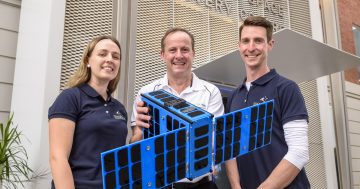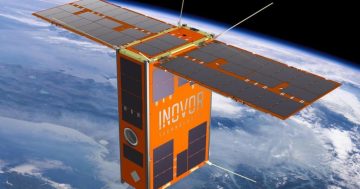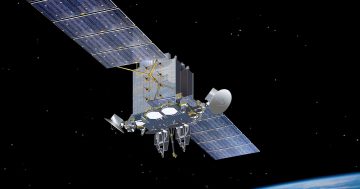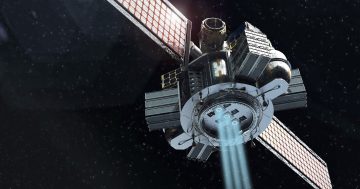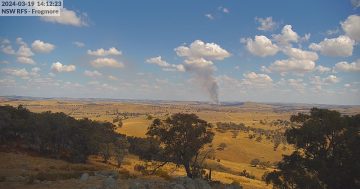Christopher Beam* says soon, satellites will be able to watch us everywhere, all the time, meaning we will have to rethink our concept of privacy.

Image: David Mark
In 2013, police in Grants Pass, Oregon, got a tip that a man named Curtis W. Croft had been illegally growing marijuana in his backyard.
So, they checked Google Earth, and the four-month-old satellite image showed neat rows of plants growing on Croft’s property.
The cops raided his place and seized 94 plants.
In 2018, Brazilian police in the State of Amapá used real-time satellite imagery to detect a spot where trees had been ripped out of the ground.
When they showed up, they discovered that the site was being used to illegally produce charcoal and arrested eight people.
Chinese Government officials have denied or downplayed the existence of Uighur re-education camps in Xinjiang Province, portraying them as “vocational schools”, but human rights activists have used satellite imagery to show that many of the “schools” are surrounded by watchtowers and razor wire.
Every year, commercially available satellite images are becoming sharper and taken more frequently.
In 2008, there were 150 Earth observation satellites in orbit; by now there are 768.
Satellite companies don’t offer 24-hour real-time surveillance, but if the hype is to be believed, they’re getting close.
Privacy advocates warn that innovation in satellite imagery is outpacing governments’ ability to regulate the technology.
Unless we impose stricter limits now, they say, one day everyone from suspicious spouses to terrorist organisations will have access to tools previously reserved for Government spy agencies.
Which would mean that at any given moment, anyone could be watching anyone else.
Commercial satellite imagery is currently in a sweet spot: powerful enough to see a car, but not enough to tell the make and model; collected frequently enough for a farmer to keep tabs on crops’ health, but not so often that people could track the comings and goings of a neighbour.
This anonymity is deliberate.
US Federal regulations, for example, limit images taken by commercial satellites to a resolution of 25 cm.
That resolution has been fine enough to satisfy most customers.
Investors can predict oil supply from the shadows cast inside oil storage tanks.
Farmers can monitor flooding to protect their crops.
But satellite imagery is improving in a way that investors and businesses will inevitably want to exploit.
The imaging company Planet Labs currently maintains 140 satellites, enough to pass over every place on Earth once a day.
Some companies are even offering live video from space.
Some of the most radical developments in Earth observation involve not traditional photography but rather radar sensing and hyperspectral images, which capture electromagnetic wavelengths outside the visible spectrum.
Clouds can hide the ground in visible light, but satellites can penetrate them using synthetic aperture radar.
It can determine the height of an object down to a millimetre.
What will make the imagery even more powerful is the ability to process it in large quantities.
Analytics companies feed visual data into algorithms designed to let anyone with an internet connection understand the pictures en masse.
Investors use this analysis to, for example, estimate the true GDP of China’s Guangdong Province on the basis of the light it emits at night.
But burglars could also scan a city to determine which families are out of town most often and for how long.
Satellite and analytics companies say they’re careful to anonymise their data, but even if satellites aren’t recognising faces, those images combined with other data streams could pose a threat to privacy.
“People’s movements, what kinds of shops do you go to, where do your kids go to school, what kind of religious institutions do you visit, what are your social patterns,” says Peter Martinez, of the Secure World Foundation.
“All of these kinds of questions could in principle be interrogated.”
One thing that might save us from celestial scrutiny is the price.
Some satellite entrepreneurs argue that there isn’t enough demand to pay for a constellation of satellites capable of round-the-clock monitoring at resolutions below 25 cm.
That said, there’s already demand for imagery with sub–25 cm resolution — and a supply of it.
Of course, drones can already collect better images than satellites ever will.
But drones are limited in where they can go.
There are no such restrictions in space.
And then there are the tracking devices we carry around in our pockets, aka smartphones.
But while the GPS data from cell phones is a legitimate privacy threat, you can at least leave your phone at home.
It’s harder to hide from a satellite camera.
Privacy laws are vague when it comes to satellites.
Cases often come down to whether an act of surveillance violates someone’s “reasonable expectation of privacy”.
A picture taken on a public sidewalk: fair game.
A photo shot by a drone through someone’s bedroom window: probably not.
A satellite orbiting hundreds of miles up, capturing video of a car pulling into the driveway? Unclear.
Human rights expert Nathaniel Raymond argues that protecting ourselves will mean rethinking privacy itself.
Current privacy laws, he says, focus on threats to the rights of individuals.
But those protections “are anachronistic in the face of AI, geospatial technologies, and mobile technologies, which not only use group data, they run on group data as gas in the tank,” Raymond says.
Regulating these technologies will mean conceiving of privacy as applying not just to individuals, but to groups as well.
“You can be entirely ethical about personally identifiable information and still kill people,” he says.
Until we can all agree on data privacy norms, Raymond says, it will be hard to create lasting rules around satellite imagery.
“We’re all trying to figure this out,” he says.
“It’s not like anything’s riding on it except the future of human freedom.”
* Christopher Beam is a writer based in Los Angeles.
This article first appeared at www.technologyreview.com.


